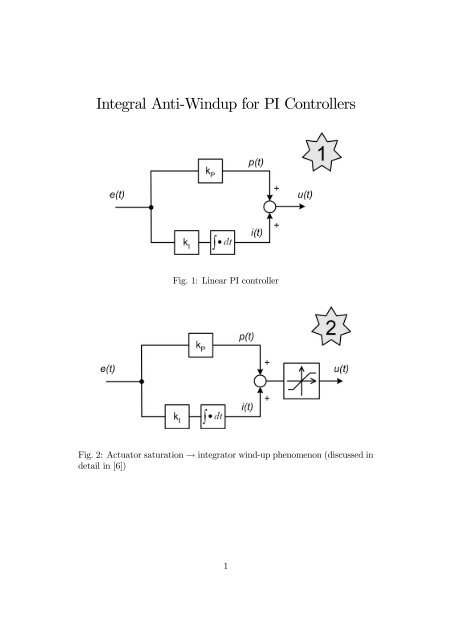Integral Anti-Windup for PI Controllers
Integral Anti-Windup for PI Controllers
Integral Anti-Windup for PI Controllers
Create successful ePaper yourself
Turn your PDF publications into a flip-book with our unique Google optimized e-Paper software.
<strong>Integral</strong> <strong>Anti</strong>-<strong>Windup</strong> <strong>for</strong> <strong>PI</strong> <strong>Controllers</strong><br />
Fig. 1: Linear <strong>PI</strong> controller<br />
Fig. 2: Actuator saturation → integrator wind-up phenomenon (discussed in<br />
detail in [6])<br />
1
Fig. 3: Limited integrator (hard limits imposed) → conditional integrator,<br />
integrator clamping [5][3]<br />
Fig. 4: Limited integrator (high feedback gain → Scheme 3) [4][1]<br />
2
Fig. 5: Tracking anti-windup [4][1][2]<br />
Fig. 6: Tracking anti-windup with unrestricted control signal (<strong>for</strong> actuators<br />
described by linear dynamics followed by a saturation) [4][1]<br />
3
Fig. 7: Tracking anti-windup, back-calculation (equivalent to Scheme 5) [4][1]<br />
Fig. 8: Modified tracking anti-windup (introduction of an additional limit on<br />
the proportional part of the control signal used to generate the anti-windupfeedback<br />
signal) [4][1]<br />
4
Fig. 9: Conditional integration (e (t) · i (t) > 0) → flexible limits (modified<br />
Scheme 3)<br />
5
Fig. 10: Integrator clamping (e (t) · u (t) > 0) → found to be the best [5][3]<br />
6
Fig. 11: Preloading ≡ The integrator output i (t) is dynamically (bumpless<br />
transfer protection) driven to the offline predetermined value i d [3]<br />
7
Fig. 12: <strong>Integral</strong> part variable limit (algorithm dynamically drives the integrator<br />
so that p (t)+i (t) lies at the edge of the saturation region), proposed<br />
in [3]<br />
8
Fig. 13: Conditional integration combinedwithback-calculationapproach<br />
(proposed in [5])<br />
9
Fig. 14: Scheme 5 and Scheme 10 per<strong>for</strong>mance comparison<br />
10
Fig. 15: Direct Stator Field Oriented Control scheme<br />
11
Fig. 16: Various DSFOC drive behaviour as a result of different <strong>PI</strong> antiwindup<br />
configuration<br />
12
Fig. 17: Model in StateFlow R° (Scheme 11)<br />
13
Fig. 18: Continuous states vs. discrete StateFlow R°<br />
14
References<br />
[1] C. Bohn and D. P. Atherton. An analysis package comparing pid antiwindup<br />
strategies. IEEE Systems Magazine, 15(2):34—40, April 1995.<br />
[2] M. Hamdan and Zhiqiang Gao. A novel pid controller <strong>for</strong> pneumatic proportional<br />
valves with hysteresis. IEEE Industry Applications Conference,<br />
2:1198—1201, October 2000.<br />
[3] A. Scottedward Hodel and C. E. Hall. Variable-structure pid control to<br />
prevent integrator windup. IEEE Transactions on Industrial Electronics,<br />
48(2):442—451, April 2001.<br />
[4] M. Tharayil and A. Alleyne. A generalized pid error governing scheme<br />
<strong>for</strong> smart/sbli control. IEEE American Control Conference, 1:346—351,<br />
May 2002.<br />
[5] A. Visioli. Modified anti-windup scheme <strong>for</strong> pid controllers. IEE Control<br />
Theory and Applications, 150(1):49—54, January 2003.<br />
[6] D. Vran˘cić. Design of <strong>Anti</strong>-<strong>Windup</strong> and bumpless Transfer Protection.<br />
PhD thesis, University of Ljubljana, Slovenia, 1997.<br />
15
















![[TCP] Opis układu - Instytut Sterowania i Elektroniki Przemysłowej ...](https://img.yumpu.com/23535443/1/184x260/tcp-opis-ukladu-instytut-sterowania-i-elektroniki-przemyslowej-.jpg?quality=85)